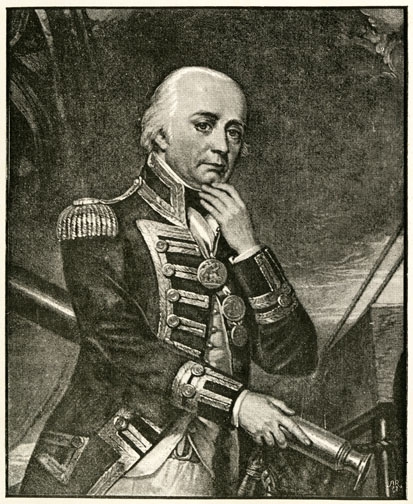
“Whenever I think how I am to be happy again, my thoughts carry me back to Morpeth.”
Vice-Admiral Cuthbert Collingwood, 1st Baron Collingwood
The 7th March 2010 marks the 200th anniversary of the death of Vice-Admiral Collingwood. This image of him is taken from the 1891 biography, Collingwood, by W.C. Russell, which was illustrated by F. Brangwyn.
Cuthbert Collingwood was born in Newcastle upon Tyne in 1748 and educated at the city’s Royal Grammar School. At the age of eleven he joined the Royal Navy. In 1777, he met Horatio Nelson, when they both served aboard HMS Lowestoffe. They rose through the ranks of the navy together. Despite their ambition there was never any jealousy between them; they were good friends who had a lot of respect for each other.
Collingwood’s career in the navy took him all over Europe, North America and the West Indies. His visits home to the northeast of England were few and far between. He returned to Newcastle in 1791 and married Sarah Blackett. The couple settled in Morpeth, Northumberland and in the next two years, they had two daughters, Sarah and Mary Patience. However, Collingwood was soon back at sea and in fact, of the forty-nine years he spent in the navy, he spent forty-four of them at sea. As a result he saw his wife and daughters infrequently and they hardly knew him.
Collingwood is most famous for his involvement in the Battle of Trafalgar. The battle, which took place on 21st October 1805, was a sea battle between the British and the combined French and Spanish fleet, during the Napoleonic Wars. The battle was the most crucial British naval victory of the wars. Twenty-seven British ships, led by Admiral Lord Nelson aboard HMS Victory, defeated thirty-three French and Spanish ships off the south-west coast of Spain, near Cape Trafalgar. Nelson was mortally wounded during the battle. History tends to give all the glory to Nelson, but, in fact, Collingwood and Nelson were equal partners. Collingwood actually fired the first shot and as Nelson lay dying, he took control of the battle and defeated the foreign forces. Thanks to him, the British didn’t lose a single ship at Trafalgar, and the country was saved from possible invasion by Napoleon’s army.
Collingwood was devoted to his country and dedicated his life to protecting it in more than one way. When he was at home in Morpeth he planted acorns whenever he spotted a good place for an oak tree to grow. It took almost 3,000 oak trees to build HMS Victory and he wanted to ensure that the British had enough oak in order to build ships to defend the country in the future.
Despite his time away from home Collingwood remained very fond of his Northumberland roots. Sadly he was never to return to his family after the Battle of Trafalgar. His health was suffering and he appealed to the Admiralty for permission to return to home for several years. On 3rd March 1810, he finally received his release orders and departed from Port Mahon in Minorca on the Ville de Paris. However, he died aboard the ship on the evening of 7th March 1810, before reaching England. He was taken to lie in state in the Painted Hall at the Old Royal Naval College in Greenwich, before being buried in St. Paul’s Cathedral, beside the tomb of his friend Nelson.
